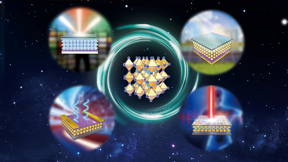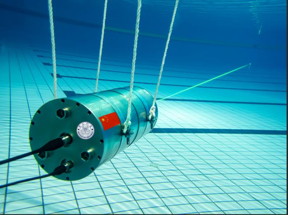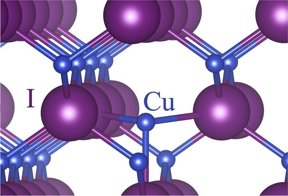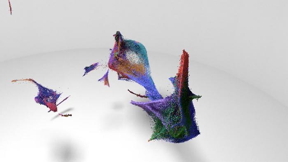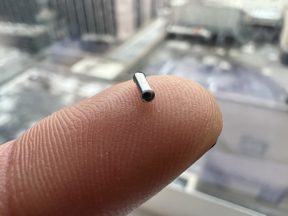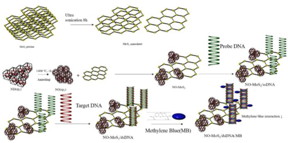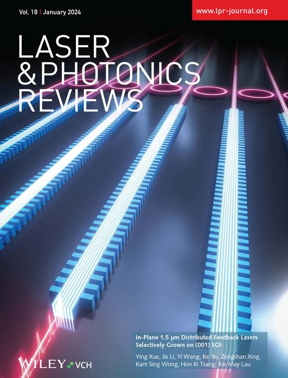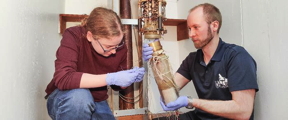Home > Press > Innovative sensing platform unlocks ultrahigh sensitivity in conventional sensors: Lan Yang and her team have developed new plug-and-play hardware to dramatically enhance the sensitivity of optical sensors
Abstract:
Optical sensors serve as the backbone of numerous scientific and technological endeavors, from detecting gravitational waves to imaging biological tissues for medical diagnostics. These sensors use light to detect changes in properties of the environment they’re monitoring, including chemical biomarkers and physical properties like temperature. A persistent challenge in optical sensing has been enhancing sensitivity to detect faint signals amid noise.
Innovative sensing platform unlocks ultrahigh sensitivity in conventional sensors: Lan Yang and her team have developed new plug-and-play hardware to dramatically enhance the sensitivity of optical sensors
St. Louis, MO | Posted on April 5th, 2024
New research from Lan Yang, the Edwin H. & Florence G. Skinner Professor in the Preston M. Green Department of Electrical & Systems Engineering in the McKelvey School of Engineering at Washington University in St. Louis, unlocks the power of exceptional points (EPs) for advanced optical sensing. In a study published April 5 in Science Advances, Yang and first author Wenbo Mao, a doctoral student in Yang’s lab, showed that these unique EPs – specific conditions in systems where extraordinary optical phenomena can occur – can be deployed on conventional sensors to achieve a striking sensitivity to environmental perturbations.
Yang and Mao developed an EP-enhanced sensing platform that overcomes the limitations of previous approaches. Unlike traditional methods that require modifications to the sensor itself, their innovative system features an EP control unit that can plug into physically separated external sensors. This configuration allows EPs to be tuned solely through adjustments to the control unit, allowing for ultrahigh sensitivity without the need for complex modifications to the sensor.
“We’ve implemented a novel platform that can impart EP enhancement to conventional optical sensors,” Yang said. “This system represents a revolutionary extension of EP-enhanced sensing, significantly expanding its applicability and universality. Any phase-sensitive sensor can acquire improved sensitivity and reduced detection limit by connecting to this configuration. Simply by tuning the control unit, this EP configuration can adapt to various sensing scenarios, such as environmental detection, health monitoring and biomedical imaging.”
By decoupling the sensing and control functions, Yang and Mao have effectively skirted the stringent physical requirements for operating sensors at EPs that have so far hindered their widespread adoption. This clears the way for EP enhancement to be applied to a wide range of conventional sensors – including ring resonators, thermal and magnetic sensors, and sensors that pick up vibrations or detect perturbations in biomarkers – vastly improving the detection limit of sensors scientists are already using. With the control unit set to an EP, the sensor can operate differently – not at an EP – and still reap the benefits of EP enhancement.
As a proof-of-concept, Yang’s team tested a system’s detection limit, or ability to detect weak perturbations over system noise. They demonstrated a six-fold reduction in the detection limit of a sensor using their EP-enhanced configuration compared to the conventional sensor.
“With this work, we’ve shown that we can significantly enhance our ability to detect perturbations that have weak signals,” Mao said. “We’re now focused on bringing that theory to broad applications. I’m specifically focused on medical applications, especially working to enhance magnetic sensing, which could be used to improve MRI technology. Currently, MRIs require a whole room with careful temperature control. Our EP platform could be used to enhance magnetic sensing to enable portable, bedside MRI.”
###
This project is supported in part by the Chan Zuckerberg Initiative (CZI). The authors acknowledge the Institute of Materials Science & Engineering (IMSE) at Washington University in St. Louis for the use of instruments, financial support and staff assistance.
####
For more information, please click here
Contacts:
Leah Shaffer
Washington University in St. Louis
Copyright © Washington University in St. Louis
If you have a comment, please Contact us.
Issuers of news releases, not 7th Wave, Inc. or Nanotechnology Now, are solely responsible for the accuracy of the content.
| Related Links |
| Related News Press |
News and information
![]()
Simulating magnetization in a Heisenberg quantum spin chain April 5th, 2024
![]()
NRL charters Navy’s quantum inertial navigation path to reduce drift April 5th, 2024
![]()
Discovery points path to flash-like memory for storing qubits: Rice find could hasten development of nonvolatile quantum memory April 5th, 2024
![]()
Good as gold – improving infectious disease testing with gold nanoparticles April 5th, 2024
Possible Futures
![]()
Discovery points path to flash-like memory for storing qubits: Rice find could hasten development of nonvolatile quantum memory April 5th, 2024
![]()
With VECSELs towards the quantum internet Fraunhofer: IAF achieves record output power with VECSEL for quantum frequency converters April 5th, 2024
![]()
Chemical reactions can scramble quantum information as well as black holes April 5th, 2024
Sensors
Discoveries
![]()
Chemical reactions can scramble quantum information as well as black holes April 5th, 2024
![]()
New micromaterial releases nanoparticles that selectively destroy cancer cells April 5th, 2024
![]()
Utilizing palladium for addressing contact issues of buried oxide thin film transistors April 5th, 2024
Announcements
![]()
NRL charters Navy’s quantum inertial navigation path to reduce drift April 5th, 2024
![]()
Discovery points path to flash-like memory for storing qubits: Rice find could hasten development of nonvolatile quantum memory April 5th, 2024
![]()
With VECSELs towards the quantum internet Fraunhofer: IAF achieves record output power with VECSEL for quantum frequency converters April 5th, 2024
Interviews/Book Reviews/Essays/Reports/Podcasts/Journals/White papers/Posters
![]()
Simulating magnetization in a Heisenberg quantum spin chain April 5th, 2024
![]()
Discovery points path to flash-like memory for storing qubits: Rice find could hasten development of nonvolatile quantum memory April 5th, 2024
![]()
Good as gold – improving infectious disease testing with gold nanoparticles April 5th, 2024
- SEO Powered Content & PR Distribution. Get Amplified Today.
- PlatoData.Network Vertical Generative Ai. Empower Yourself. Access Here.
- PlatoAiStream. Web3 Intelligence. Knowledge Amplified. Access Here.
- PlatoESG. Carbon, CleanTech, Energy, Environment, Solar, Waste Management. Access Here.
- PlatoHealth. Biotech and Clinical Trials Intelligence. Access Here.
- Source: http://www.nanotech-now.com/news.cgi?story_id=57475
- :has
- :is
- :not
- :where
- $UP
- 000
- 10
- 12th
- 17th
- 2024
- 3rd
- 5
- 5th
- 7th
- 8th
- a
- ability
- accuracy
- Achieve
- Achieves
- acknowledge
- acquire
- adapt
- addressing
- adjustments
- Adoption
- advanced
- advances
- Allowing
- allows
- already
- Amid
- an
- and
- any
- applications
- applied
- approaches
- April
- ARE
- around
- AS
- Assistance
- At
- atom
- author
- authors
- autonomous
- awarded
- Backbone
- BE
- been
- benefits
- bind
- biomarkers
- biomedical
- Black
- boasts
- Bringing
- broad
- bulletproof
- but
- by
- CAN
- Cancer
- carbon
- careful
- Center
- CGI
- challenge
- chan
- Changes
- chemical
- chemistry
- click
- cold
- color
- COM
- comment
- commitment
- compared
- compatible
- complex
- conditions
- conducted
- Configuration
- Connecting
- contact
- content
- control
- conventional
- cost-effective
- could
- created
- critical
- Currently
- December
- del
- demonstrated
- Department
- deployed
- destroy
- detect
- detecting
- Detection
- develop
- developed
- Development
- device
- Devices
- Diagnostics
- different
- differently
- discover
- Disease
- doesn
- dramatically
- drug
- Edwin
- effectively
- enable
- end
- endeavors
- energy
- Engineering
- enhance
- enhancement
- enhancing
- Environment
- environmental
- especially
- Ether (ETH)
- exceptional
- expanding
- experiments
- extension
- external
- extraordinary
- faint
- far
- Features
- Film
- financial
- Find
- First
- focused
- For
- Foundation
- Frequency
- from
- fu
- functions
- fundamental
- gif
- Gold
- Graphene
- gravitational
- Gravitational waves
- greater
- Green
- Hardware
- Harvesting
- Have
- Health
- help
- helped
- her
- http
- HTTPS
- if
- Imaging
- implemented
- improve
- improved
- improving
- in
- Inc.
- Including
- inexpensive
- infectious
- information
- Initiative
- innovative
- Institute
- instruments
- International
- international space station
- Internet
- into
- issues
- ITS
- itself
- January
- just
- lab
- li
- light
- like
- LIMIT
- limitations
- links
- Louis
- make
- material
- materials
- mechanical
- medical
- Medical Applications
- Memory
- method
- methods
- Modifications
- monitoring
- more
- MRI
- multiple
- nanotechnology
- Nature
- Navigation
- Need
- net
- New
- news
- nicholas
- Noise
- novel
- November
- now
- numerous
- occur
- of
- on
- operate
- operating
- optical
- Optimize
- or
- our
- output
- over
- palladium
- part
- path
- Paul
- phase
- PHP
- physical
- Physically
- physicist
- pick
- platform
- plato
- Plato Data Intelligence
- PlatoData
- please
- plug
- points
- portable
- Post
- posted
- power
- press
- Press Release
- previous
- probe
- producing
- Professor
- project
- properties
- published
- Quantum
- Quantum Frequency
- quantum information
- Quantum Internet
- qubits
- range
- reactions
- reap
- record
- reduce
- Reduced
- reduction
- release
- Releases
- Renowned
- represents
- require
- Requirements
- research
- researchers
- responsible
- return
- revolutionary
- Rice
- Ring
- Rival
- robots
- Room
- s
- Said
- Save
- scenarios
- School
- School of Engineering
- Science
- scientific
- scientists
- Search
- sense
- Sensitivity
- sensors
- serve
- set
- Share
- showed
- shown
- signals
- significantly
- Simple
- simply
- simultaneously
- SIX
- Skin
- So
- so Far
- Soft
- solely
- Space
- space station
- specific
- specifically
- Spin
- st
- Staff
- start
- station
- Step
- Still
- storing
- strength
- stringent
- strong
- Student
- Study
- submit
- such
- support
- Supported
- system
- Systems
- T
- team
- technological
- Technologies
- Technology
- tested
- Testing
- than
- that
- The
- the world
- their
- theory
- thermal
- These
- they
- thin
- this
- Through
- times
- tissues
- to
- together
- tools
- toward
- towards
- traditional
- tuned
- tuning
- Ultra
- unique
- unit
- university
- unlike
- unlocks
- us
- use
- used
- uses
- using
- various
- W
- washington
- Wave
- waves
- Way..
- we
- wearable
- WELL
- which
- whole
- wide
- Wide range
- widespread
- will
- with
- without
- Work
- working
- world
- Yahoo
- Yield
- you
- zephyrnet
- Zuckerberg










